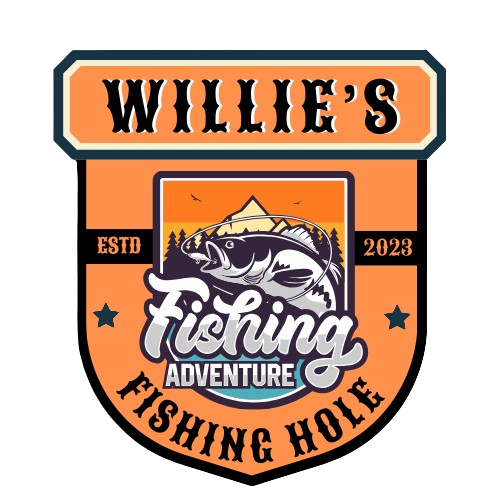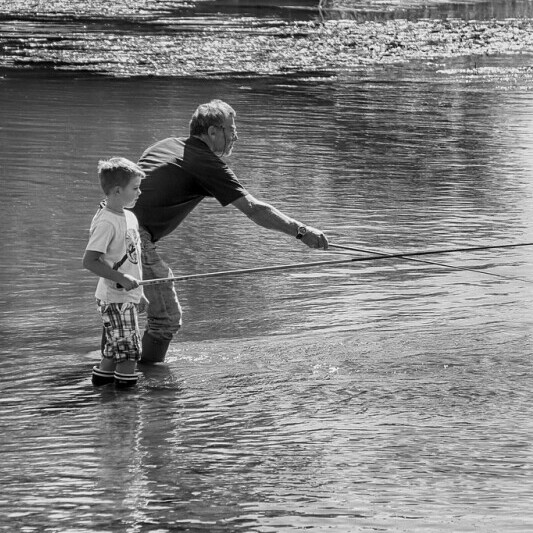Fishing is a timeless activity that can provide endless adventure, relaxation, and outdoor therapy. It is a great way to spend time with your family. I treasured those days with my Father and Grandfathers. Whether you’re a seasoned angler or just starting out, the thrill of casting a line and reeling in a fish is hard to beat. But if you’re new to the sport, it can be tough to know where to get started. That’s why we’ve put together the ultimate guide on how to get started fishing! From selecting the right gear to understanding fish behavior, we’ll help you navigate the waters and start to “Cast & Splash” with the best of them.
Selecting the Right Gear: Equipping Yourself for Success
Before you dive into the world of fishing, you’ll need to equip yourself with the right gear. But when you’re just starting out, it can be overwhelming to know where to start. Here are the essentials that you’ll need:
- Fishing rod: A fishing rod is the backbone of your gear, and it’s important to choose the right one for your needs. There are many different types of fishing rods to choose from, including fly rods, spinning rods, and baitcasting rods. For beginners, I recommend starting with a spinning rod, which is easy to use and versatile. Don’t get hung up on the length of the rod at this point. Stick with something that is easy to handle and feels comfortable in your hands. For the young ones (10 and under) I suggest a 6′ rod or under in length. Everyone else, you are free to choose based on the way it feels but, I would not buy anything longer than 7′ to start with. It is important to note here that certain length rods are typically used in specific fishing adventures. We will cover those in future articles.
- Fishing reel: Your fishing reel is what holds your fishing line and helps you reel in your catch. Like fishing rods, there are many different types of fishing reels to choose from. For beginners, there are really only 2 main types of reels I would suggest, a spinning reel or a spincast reel. The younger angler may find the spincast reel easier to learn with and more fun at the start as it utilizes a button release for casting. A spinning reel is also a great choice but, you need to hold the line with your index finger while you cast and release the line at just the right point for a smooth cast. I do not suggest a bait casting reel. These reels require various items to be setup, typically based on the bait you are using, and will only frustrate a beginner and ultimately turn them off this great pastime.
- Fishing line: Your fishing line is what connects your rod to your lure or bait. There are many different types of fishing lines to choose from, including monofilament, fluorocarbon, and braided lines. For beginners, I recommend starting with monofilament line, as it’s easy to handle and versatile. As you learn the sport, you will find you will switch to different types of lines based on your fishing adventure. I will cover the different lines in more detail in another article.
- Fishing hooks: Your fishing hook is what will catch the fish, and there are many different types and sizes of hooks to choose from. There are Sedge, Shrimp, Octopus, Wide Gape, Bait holder, Sickle to name a few. The type of bait your are using, worms, plastic baits, spawn, beads etc. will dictate the size and type of hook you use. For beginners, I recommend starting with basic bait hooks, which are easy to use and versatile.
Once you have your basic gear in place, you can start to build your fishing arsenal with lures, bait, sinkers and other accessories. But for now, keep it simple and focus on the basics.
Choosing the Right Fishing Spot: Where to Cast Your Line
Selecting the right fishing spot is critical to your success as an angler. Here are some tips to help you choose the right location:
- Research local fishing spots: Start by researching the local fishing spots in your area. This could include lakes, rivers, ponds, and other bodies of water.
- Consider the type of fish you want to catch: Different types of fish prefer different types of environments. For example, bass prefer warm water and cover, while trout prefer cold water and open areas.
- Look for areas with structure: Fish tend to congregate around underwater structures like rocks, logs, and weed beds. Look for areas with these types of structures to increase your chances of catching a fish.
- Take into account the time of day and weather conditions: Fish are more active during certain times of day and in certain weather conditions. For example, bass are more active in the early morning and late evening, while trout are more active in cloudy weather.
By taking these factors into account, you can find the perfect fishing spot for your needs. With any fishing expedition, be sure you are respectful of property you may have to cross and obey No Trespassing signs. Ask for permission to cross a property to get to your fishing hole. Always clean up after yourself. Do not leave loose line, hooks, fish cleanings or garbage lying around. Keep the spot clean so you can continue to use it and so that our environment is maintained.
Learning Basic Fishing Techniques: Become a Master of the Cast
Casting a fishing line may seem intimidating at first, but with a little practice, you’ll be reeling in fish like a pro. Here’s how to get started with a spinning reel:
- Hold the fishing rod with your dominant hand: If you’re right-handed, hold the rod with your right hand. If you’re left-handed, hold the rod with your left hand.
- Place your other hand on the reel: Hold the reel with your other hand and use your index finger to hold the line against the rod.
- Turn your body sideways: Stand sideways to the water with your feet shoulder-width apart. This will help you make a smooth cast.
- Hold the rod at a diagonal angle: Hold the rod at a diagonal angle with the tip pointed towards the water.
- Pull the rod back: Pull the rod back towards your shoulder, keeping your elbow close to your body.
- Swing the rod forward: Swing the rod forward in a smooth motion, releasing the line with your finger as the rod tip reaches the forward position.
You don’t have to wait until you go fishing to practice casting. It is a technique that takes time to master. You can practice onshore simply by tying a drop sinker to the end of your line. It won’t grab the grass, it gives you some weight to cast with and let’s you develop a good technique. Just don’t throw toward the windows!
Understanding Fish Behavior: A Deep Dive into Their World
Understanding fish behavior is key to successful fishing, and there are many factors that can influence fish activity. Here are some tips to help you read the water and identify potential fish habitats:
- Look for underwater structures: As I mentioned earlier, fish tend to congregate around underwater structures like rocks, logs, and weed beds.
- Pay attention to water temperature: Different types of fish prefer different water temperatures. This is particularly important when you are trolling in a boat, which is an article for another time. For example, bass prefer warm water, while trout prefer colder water.
- Keep an eye on the weather: Fish are more active in certain weather conditions. Generally, overcast days or days with light rain tend to be good for fishing. Muddy rivers or streams are better fishing than when they are clear with little to no bottom stirred up.
- Be mindful of the time of day: Fish are more active during certain times of day, such as early morning and late evening.
By taking these factors into account, you can increase your chances of catching a fish.
Getting Familiar with Fishing Regulations: Stay on the Right Side of the Line
Fishing regulations help to ensure that fish populations remain healthy and sustainable. Before you start fishing, it’s important to familiarize yourself with the local regulations in your area. Here are some tips to help you do that:
- Research local fishing regulations: Look up the local fishing regulations in your area to make sure you understand the rules and guidelines.
- Follow catch-and-release practices: Catch-and-release is a great way to ensure that fish populations remain healthy. If you’re going to release a fish back into the water, handle it gently and release it quickly.
- Buy a fishing license: In most areas, you’ll need a fishing license to legally fish. Make sure you have the appropriate license before you start fishing. However, in some jurisdictions there are days, weekends or weeks where you do not require a license to fish. These are great times to try it. Find a local tackle shop that might rent equipment and see if it is worth getting your own gear.
By following these guidelines, you can enjoy fishing while also helping to preserve fish populations for future generations. Hop over to my Resources Page for local regulation websites.
Joining the Fishing Community: Netting Connections and Experiences
One of the great things about fishing is the sense of community that it fosters. Whether you join a local fishing club or participate in online forums, there are many opportunities to connect with other anglers and share your experiences or just ask for some guidance. Here are some tips to help you get started:
- Join a local fishing club: Local fishing clubs are a great way to connect with other anglers in your area. Many clubs offer educational programs, fishing trips, and other events. By joining a local club you will also be supporting the local fishery. you can help with the stocking of fish, cleaning up the fishing areas and so much more.
- Participate in online forums: There are many online forums and communities dedicated to fishing. Facebook, YouTube Channels, Instagram and Twitter are just a few online forums. These can be a great place to ask questions, share tips, and connect with other anglers that are local to you or from around the world.
- Learn from experienced anglers: If you know an experienced angler, ask them to take you fishing and show you the ropes. You’d be surprised how much you can learn from someone with years of experience. Some of the bigger names in fishing also have Facebook pages where you can follow them, ask questions and learn what they are doing to catch fish.
- Learn from tackle companies: Did you know that most tackle manufactures have a how to section on their website or have a Facebook page stuffed full of tips? Search for them and save their links or join their Facebook pages. A lot of the smaller tackle shops even provide recommendations on other tackle they use and where to get it.
By connecting with the fishing community, you can learn new skills, make new friends, and share your love of fishing with others.
Final Thoughts
Some final thoughts here. Fishing is a fun and rewarding activity that can provide endless adventure, relaxation, and outdoor therapy. It is a way to connect with family, friends and other like minded anglers. By following these tips and guidelines, you can get started with fishing and start exploring the world of angling. Remember to have fun, be safe, be respectful of the environment and others and enjoy all that the great outdoors has to offer. Happy fishing and please leave any comments of your first fishing adventure below.

